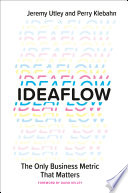

Diversity plays a pivotal role in enhancing ideaflow, as varied perspectives lead to richer idea generation. The book discusses how diverse teams are more likely to produce innovative solutions because they approach problems from different angles. The author emphasizes the importance of inclusivity in the workplace and provides actionable insights on how to build diverse teams. By embracing diversity, organizations can tap into a wider range of experiences and viewpoints, ultimately improving their ideaflow and driving better business outcomes.
Continue readingIdeaflow refers to the continuous generation, refinement, and implementation of ideas within an organization. The book emphasizes that the ability to maintain a healthy ideaflow is crucial for innovation and adaptability. Organizations that foster a culture of ideaflow can respond more effectively to market changes, customer needs, and technological advancements. This concept is rooted in the belief that ideas are the lifeblood of any organization, and without a steady stream of fresh ideas, businesses risk stagnation. The author argues that leaders should prioritize creating an environment where ideas can flourish, thereby enhancing creativity and collaboration among teams.
Continue readingTo harness ideaflow, organizations must cultivate a culture that encourages experimentation and risk-taking. The book outlines practical strategies for leaders to implement, such as establishing open communication channels, promoting cross-functional collaboration, and rewarding innovative thinking. By fostering a safe space for employees to share their ideas without fear of criticism, organizations can unlock the potential of their workforce. The author shares case studies of companies that have successfully implemented these practices, demonstrating how a supportive culture can lead to breakthrough innovations and sustained competitive advantage.
Continue readingThe author introduces various tools and techniques that can help organizations boost their ideaflow. These include brainstorming sessions, design thinking workshops, and innovation sprints. The book provides step-by-step guidance on how to effectively implement these methods, ensuring that teams can generate and refine ideas efficiently. Additionally, the author highlights the importance of using technology to facilitate ideaflow, such as collaboration platforms and idea management software. By leveraging these tools, organizations can streamline their ideation processes and enhance overall productivity.
Continue readingTo ensure that ideaflow is effectively contributing to organizational goals, it is essential to establish metrics for success. The book discusses various key performance indicators (KPIs) that can be used to assess the impact of ideaflow on innovation and business performance. These metrics may include the number of ideas generated, the rate of idea implementation, and the overall impact of innovations on revenue and customer satisfaction. By tracking these metrics, organizations can identify areas for improvement and make data-driven decisions to enhance their ideaflow.
Continue readingThe book addresses common barriers that hinder ideaflow, such as organizational silos, resistance to change, and fear of failure. The author provides strategic insights on how to overcome these obstacles, emphasizing the need for leadership commitment and a clear vision for innovation. By actively working to dismantle silos and promote a culture of openness, organizations can create an environment conducive to ideaflow. The book also discusses the importance of resilience and adaptability in navigating challenges, encouraging leaders to foster a mindset that embraces change.
Continue readingFinally, the book explores the importance of sustaining ideaflow in the long term. The author argues that organizations must continuously adapt and evolve their ideaflow practices to remain competitive. This involves regularly revisiting and updating ideation processes, investing in employee training, and staying attuned to market trends. The book provides insights on how to create a feedback loop that ensures ideaflow remains a dynamic and integral part of the organizational culture. By committing to the ongoing development of ideaflow, organizations can ensure they remain innovative and responsive to changing business landscapes.
Continue reading